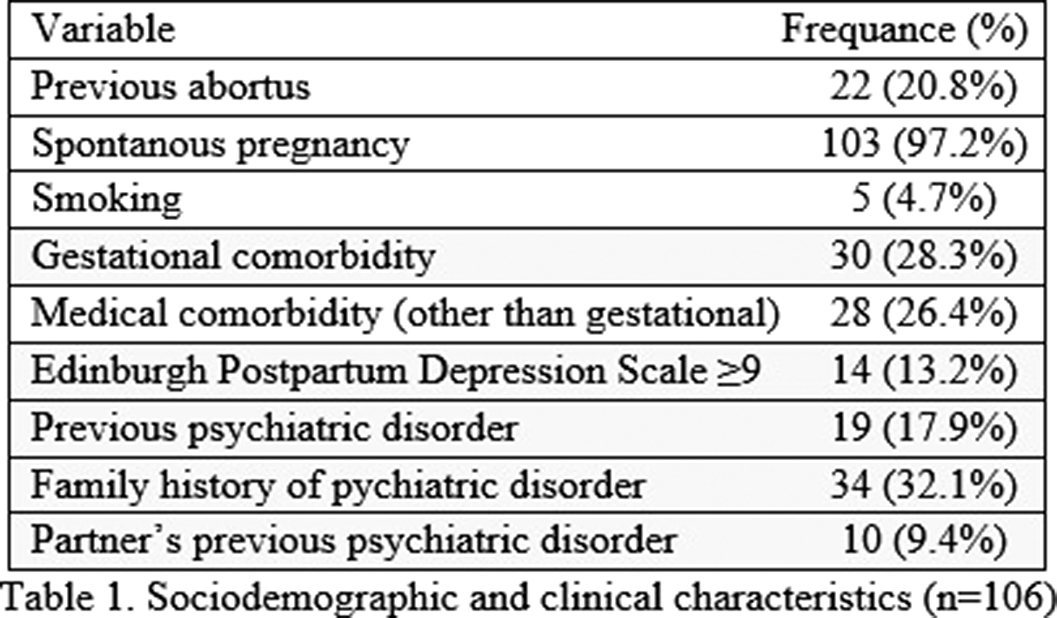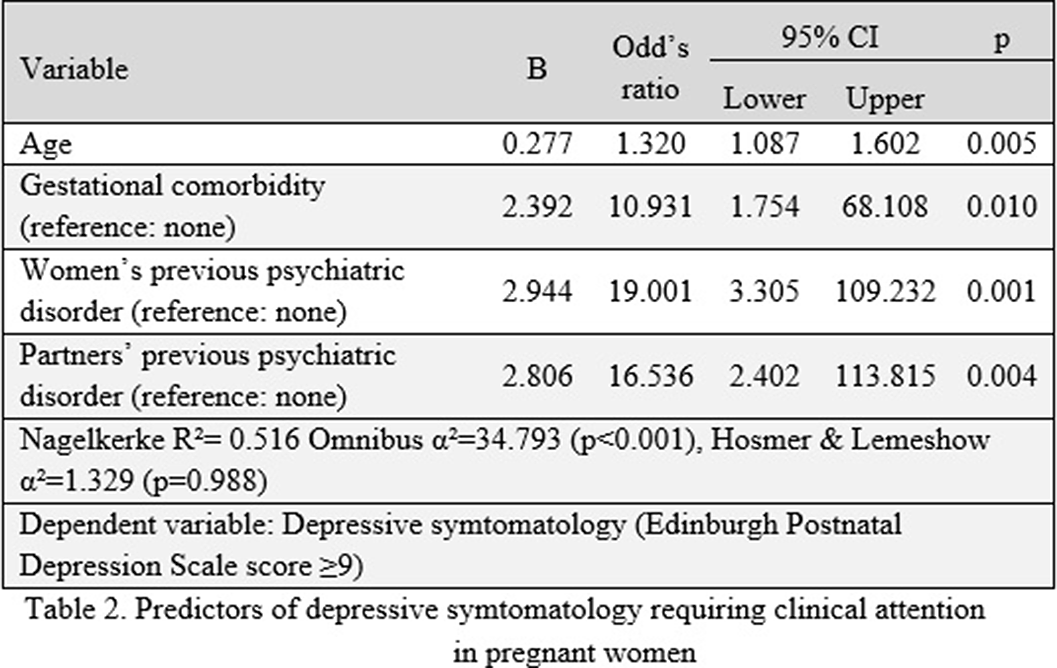58 results
Swipe & Slice: Decoding Digital Struggles with NSSI in Young Italians
-
- Journal:
- European Psychiatry / Volume 67 / Issue S1 / April 2024
- Published online by Cambridge University Press:
- 27 August 2024, p. S170
-
- Article
-
- You have access
- Open access
- Export citation
Can high-sensitivity C-reactive protein be a routine trans-diagnostic biomarker for thoughts of death and suicidal attempts?
-
- Journal:
- European Psychiatry / Volume 67 / Issue S1 / April 2024
- Published online by Cambridge University Press:
- 27 August 2024, p. S783
-
- Article
-
- You have access
- Open access
- Export citation
Temperamental differences in the Subtypes of Attention Deficit Hyperactivity Disorder
-
- Journal:
- European Psychiatry / Volume 67 / Issue S1 / April 2024
- Published online by Cambridge University Press:
- 27 August 2024, pp. S168-S169
-
- Article
-
- You have access
- Open access
- Export citation
Psychopathological characterization of nomophobia in a sample of patients with severe mental illness
-
- Journal:
- European Psychiatry / Volume 67 / Issue S1 / April 2024
- Published online by Cambridge University Press:
- 27 August 2024, p. S375
-
- Article
-
- You have access
- Open access
- Export citation
Proton and helium ions acceleration in near-critical density gas targets by short-pulse Ti:Sa PW-class laser
- Part of
-
- Journal:
- Journal of Plasma Physics / Volume 89 / Issue 6 / December 2023
- Published online by Cambridge University Press:
- 28 December 2023, 965890601
-
- Article
-
- You have access
- Open access
- HTML
- Export citation
Digitalising mental health care: Practical recommendations from the European Psychiatric Association
-
- Journal:
- European Psychiatry / Volume 67 / Issue 1 / 2024
- Published online by Cambridge University Press:
- 13 December 2023, e4
-
- Article
-
- You have access
- Open access
- HTML
- Export citation
The future of diagnosis in clinical neurosciences: Comparing multiple sclerosis and schizophrenia
-
- Journal:
- European Psychiatry / Volume 66 / Issue 1 / 2023
- Published online by Cambridge University Press:
- 21 July 2023, e58
-
- Article
-
- You have access
- Open access
- HTML
- Export citation
Boredom, emotional dysregulation and avoidance coping strategies: Which is their role in youth mood disorders?
-
- Journal:
- European Psychiatry / Volume 66 / Issue S1 / March 2023
- Published online by Cambridge University Press:
- 19 July 2023, pp. S716-S717
-
- Article
-
- You have access
- Open access
- Export citation
Psychopathological characterization of modern-type depression in subjects with Internet Gaming Disorder
-
- Journal:
- European Psychiatry / Volume 66 / Issue S1 / March 2023
- Published online by Cambridge University Press:
- 19 July 2023, p. S1001
-
- Article
-
- You have access
- Open access
- Export citation
Eveningness chronotype and depressive affective temperament associated with higher high-sensitivity C-Reactive Protein in Unipolar and Bipolar Depression
-
- Journal:
- European Psychiatry / Volume 66 / Issue S1 / March 2023
- Published online by Cambridge University Press:
- 19 July 2023, p. S247
-
- Article
-
- You have access
- Open access
- Export citation
Expectant Fathers’ Mental Health History Predicts Actual Depressive Symptomatology in Pregnant Women
-
- Journal:
- European Psychiatry / Volume 66 / Issue S1 / March 2023
- Published online by Cambridge University Press:
- 19 July 2023, p. S653
-
- Article
-
- You have access
- Open access
- Export citation
The mediating role of the boredom and loneliness dimensions in the development of Problematic Internet Use
-
- Journal:
- European Psychiatry / Volume 66 / Issue S1 / March 2023
- Published online by Cambridge University Press:
- 19 July 2023, pp. S623-S624
-
- Article
-
- You have access
- Open access
- Export citation
Longer-term effectiveness of a heterologous coronavirus disease 2019 (COVID-19) vaccine booster in healthcare workers in Brazil
-
- Journal:
- Antimicrobial Stewardship & Healthcare Epidemiology / Volume 3 / Issue 1 / 2023
- Published online by Cambridge University Press:
- 22 June 2023, e104
-
- Article
-
- You have access
- Open access
- HTML
- Export citation
The effectiveness of coronavirus disease 2019 (COVID-19) vaccine in the prevention of post–COVID-19 conditions: A systematic literature review and meta-analysis
-
- Journal:
- Antimicrobial Stewardship & Healthcare Epidemiology / Volume 2 / Issue 1 / 2022
- Published online by Cambridge University Press:
- 06 December 2022, e192
-
- Article
-
- You have access
- Open access
- HTML
- Export citation
Whis is the opinion of Italian psychiatrists regarding Telepsychiatry?
-
- Journal:
- European Psychiatry / Volume 65 / Issue S1 / June 2022
- Published online by Cambridge University Press:
- 01 September 2022, pp. S167-S168
-
- Article
-
- You have access
- Open access
- Export citation
Aripiprazole lai two-injection start in a 16 year-old with Schizophrenia
-
- Journal:
- European Psychiatry / Volume 65 / Issue S1 / June 2022
- Published online by Cambridge University Press:
- 01 September 2022, p. S796
-
- Article
-
- You have access
- Open access
- Export citation
Clozapine-Treatment-Resistant Schizophrenia Successfully Managed with Brexpiprazole Combination Therapy: Two Case Reports
-
- Journal:
- European Psychiatry / Volume 65 / Issue S1 / June 2022
- Published online by Cambridge University Press:
- 01 September 2022, pp. S355-S356
-
- Article
-
- You have access
- Open access
- Export citation
The impact of the Covid-19 pandemic on peripartum affective psychopathology
-
- Journal:
- European Psychiatry / Volume 65 / Issue S1 / June 2022
- Published online by Cambridge University Press:
- 01 September 2022, pp. S103-S104
-
- Article
-
- You have access
- Open access
- Export citation
Long-acting Paliperidone Palmitate treatment in an Ekbom’s Syndrome secondary to Lewy Body Dementia: A case report
-
- Journal:
- European Psychiatry / Volume 65 / Issue S1 / June 2022
- Published online by Cambridge University Press:
- 01 September 2022, p. S477
-
- Article
-
- You have access
- Open access
- Export citation
An observational naturalistic study on non-suicidal self-harm behaviours in a cohort of adolescents and young inpatients during COVID-19 outbreak
-
- Journal:
- European Psychiatry / Volume 65 / Issue S1 / June 2022
- Published online by Cambridge University Press:
- 01 September 2022, p. S255
-
- Article
-
- You have access
- Open access
- Export citation





